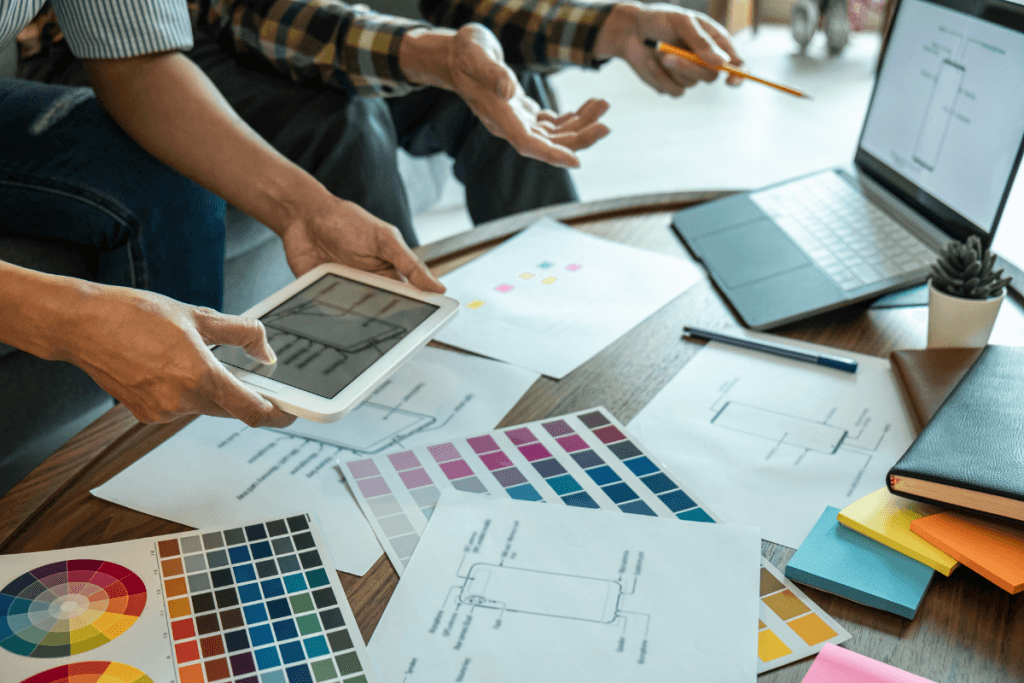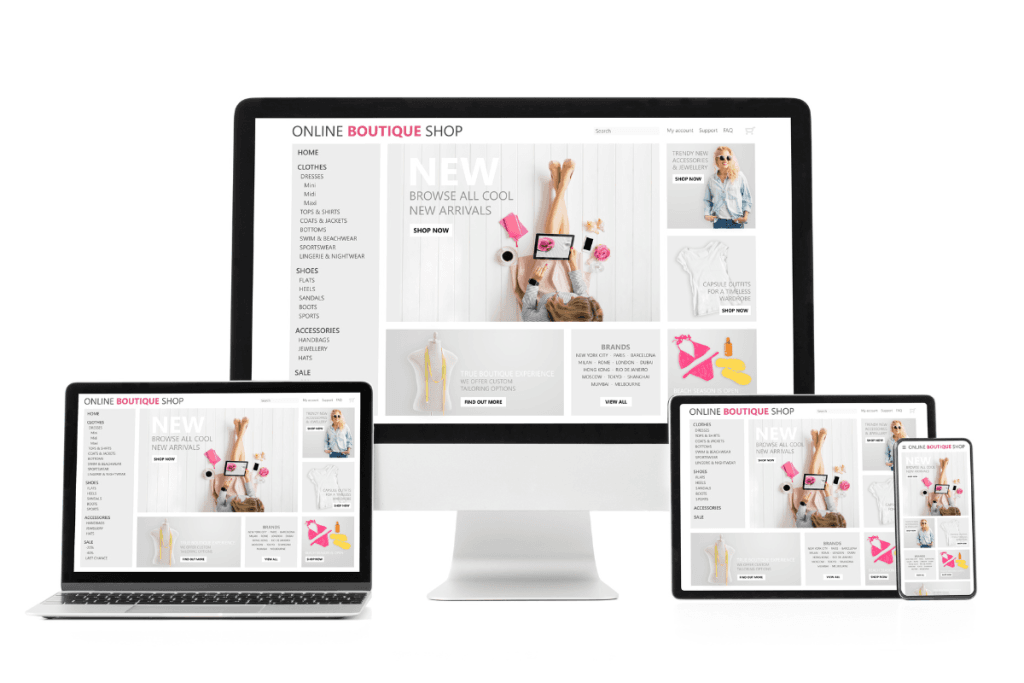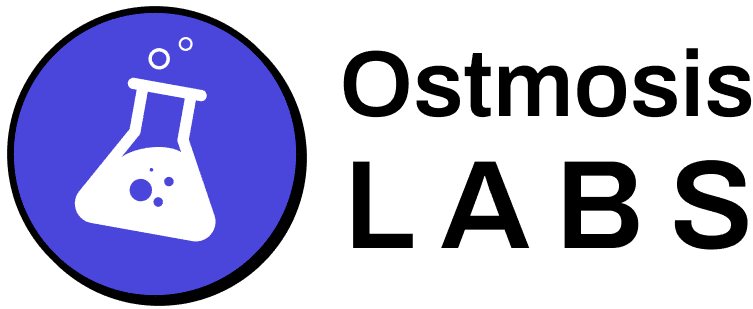When you stumble upon a beautifully designed website that’s highly intuitive and functional, it’s easy to gloss over the detail and effort involved in its creation. The truth is that every feature, every piece of content, and every line of code has been meticulously planned and implemented to ensure an effortless user journey.
Website design development begins with discovering and understanding the client’s business type, product or service, target audience, and objectives for the website. Once the project scope is clear, a sitemap is created, providing a clear roadmap of the website’s proposed structure. This stage may also involve creating wireframes for pivotal website pages. This planning phase is also the perfect time to choose the technology stack that will best serve the project
Here, we delve behind the screens to explore what goes into making a dynamic and engaging website.
Doing The Brief And Goal Identification
A crucial aspect of web design development is understanding the goals of a website and tailoring the experience accordingly. With this in mind, let’s explore two essential elements in defining a project’s success:
1. Clear and Measurable Goals
Identifying objectives and setting measurable targets from the outset ensures a focused and effective web development process. Whether it’s driving sales, increasing engagement, or promoting brand awareness – clarity of purpose shapes every design decision.
2. Understanding User Demographics and Actions
Knowing the target demographic and their likely behavior helps create a captivating user experience. Data-driven insights and a deep understanding of user intentions lay the foundation for a website that meets its users’ needs and expectations. This includes:
- Creating a responsive layout and navigational framework
- Employing appropriate font choices to enhance accessibility
- Implementing seamless front-end and back-end systems
- Ensuring compatibility with a variety of programming languages
Web design development combines aesthetics and user experience, empowering web designers and developers to craft tailored experiences that resonate with their audience. By establishing goals and understanding the user demographic, Ostmosis Labs ensures each website is purpose-driven and primed for success.

Wireframing And The Website Layout Design
A website wireframe is the visual representation of a website’s skeletal framework. It helps front-end developers craft a navigational system, blocks to distribute content and features and determine the placement of core elements of web design. Think of wireframes as the foundational groundwork before jumping into coding languages like HTML or CSS.
Visual Hierarchy, Aesthetic Appeal, and Functionality
With the wireframes ready, professional web designers utilize design tools like Adobe’s suite to create a responsive web design embodying visual design principles. The process involves balancing an engaging aesthetic with functionality—ensuring users find the information they need effortlessly while enjoying a pleasing design. Key considerations include:
- Best practices for visual hierarchy
- Ensuring compatibility across web browsers
- Designing elements that mirror the website’s purpose
As we continually learn and adapt, we realize that the art of creating a successful website lies in the right equilibrium between design aesthetics and user functionality. After all, great web design isn’t just about how a website looks but also how it works.
Color Scheme And Typography
A web designer wears multiple hats in web design and development. They’re not merely developers fluent in HTML, CSS, and JavaScript. They’re artists mastering the subtle blend of color and typography to create visually stunning and accessible experiences.
- Power of Color: Colors are not just decorative elements. They evoke emotions, influence mood, and impact user experience. Selecting the right color palette in website design is significant, resonating with the target audience while enhancing usability.
- The Art of Typography: Typography can make or break a design. A well-chosen font enhances readability, supplemented by effective use of HTML and CSS to ensure a clutter-free and responsive layout.
- Balancing Aesthetics and Accessibility: Tying color and typography with other elements like wireframes and Python or JavaScript coding shapes your site’s navigation and user interface. It’s a delicate balancing act ensuring the webpage is aesthetically pleasing and, simultaneously, easy to navigate.
To progress as a front-end or back-end developer, one must embrace the harmonious marriage of aesthetics and coding. Whether you aim to learn the basics or refine your skills, these fundamentals are pivotal for creating engaging, accessible platforms.

Graphic Design And Imagery
Weaving the visual fabric of a website is an art unto itself in web design development. The web design concept extends beyond colors, typography, or layout design. It encapsulates elements from the intriguing world of graphic design.
Quality visual content isn’t just an accessory to written text. Images, icons, infographics, and animations can:
- Add depth to the narrative
- Enhance information absorption
- Increase engagement
These design elements are pivotal to creating a responsive web design. They contribute to the look and feel of a website, acting as visual storytellers, holding the potential to make complex concepts digestible.
But don’t be fooled—there’s a science behind the magic. The process of creating a website involves considering such factors as:
- Correspondence with the website’s purpose
- Adhering to best practices of design
- Compatibility across web browsers
So, if you’re a budding web designer eager to learn web design, harness design tools like Adobe and intertwine coding language knowledge with visual design principles.
In doing so, you’ll create sites that viewers enjoy browsing and are a joy to develop!
Superb UX And UI
Two critical aspects dominate the realm of web design and development — User Interface (UI) and User Experience (UX). As a web designer, to create a website that captivates and retains users, it’s essential to deeply understand and harmonize both.
- User Interface (UI): Think of UI as the platform where interaction happens. It’s your task to design a visually appealing and intuitive environment using layout, buttons, images, text inputs, and more, aided by HTML, CSS, and JavaScript.
- User Experience (UX): UX is the essence of the user’s journey on your site. It’s about how they feel, how easily they can navigate, and their overall satisfaction in the process, all perfected with responsive design and easy navigation.
These concepts imbue your site with life in front-end and back-end web development. A well-built UI makes the site aesthetically pleasing, while a thought-out UX ensures seamless navigation and functionality.
Coding The Design
Once the visual elements of web design have been perfected, it’s time for the developer to step into the limelight, transforming the static design into a dynamic, fully functioning website. Utilizing their expertise in coding languages such as HTML, CSS, and JavaScript, web developers bring to life the sketches and mockups created by web designers.
The culmination of this process is a responsive web design. But what does that mean?
A responsive web design refers to:
- A fluid grid layout that adapts to various screen sizes
- Flexible media (pictures and videos) that scale in relation to their containing element
- Media queries that apply different CSS styles to different devices
In essence, it ensures your website’s layout is user-friendly and aesthetically beautiful, no matter the device the user is on – be it a high-fidelity desktop screen or a compact mobile phone.

Testing, Review, And Launch
Each website’s web design and development journey culminates in an all-important final stage — testing, review, and launch.
Testing involves:
- Checking every button, link, and form meticulously for functionality
- Searching for bugs in the HTML, CSS, and JavaScript code, doing necessary debugging
Review
- Layout
- Navigation: Is it clear and intuitive?
- Accessibility: Can all users access the information they need regardless of ability?
- Aesthetics: Does the website embody the design concept envisaged at the beginning?
Once the website has sailed through testing and review, it’s time to launch, an exciting moment that marks the embodiment of your hard work, creativity, and web development skills.
Onward and upward!
The Maintenance And Update Process
Congratulations! Your website has taken flight. It’s time to ensure it soars steadily through maintenance and updating. Websites, unlike architectural structures, are not ‘set and forget’. Maintaining and updating your website is crucial. Here’s why:
- Relevance: Regularly updated content engages users and boosts your search engine rankings.
- Functionality: Website technologies evolve rapidly. Regular updates keep your website compatible with new web browsers and design tools and ensure responsiveness, thereby enhancing the overall user experience.
- Security: Cyber threats are a bitter reality of the digital world. Safeguard your website by regularly implementing updates and security patches.
Onward and upward, future front-end developers and web designers. The road to becoming a skilled web developer is paved with constant learning, practice, and curiosity to create.
The process of web design development is like choreographing a ballet – every move is precise and has a purpose. It’s a harmonious, meticulous, and ongoing process that requires creativity, technological prowess, and a deep understanding of the audience to create masterpieces that tell stories and generate engagement.


